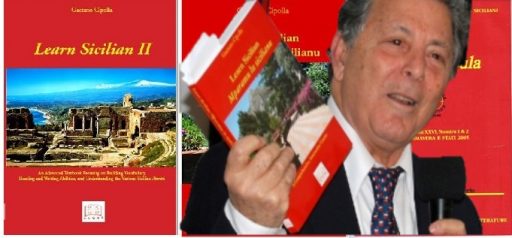By Antonio Pagano
Professor Gaetano Cipolla presented his new book, Learn Sicilian II, just published by Legas, at the Columbus Citizens Foundation in Manhattan on November 30, 2021. The event, which was open to the members of the Foundation and to the public, was attended by Arba Sicula members from the tri-state area and by lovers of Sicilian culture. One person came down from Rochester, New York, to hear the presentation. The lecture room in the elegant townhouse on East 69th Street, just off Fifth Ave, was filled to capacity, even though there was a charge of $35.00 to attend the presentation. But in exchange, everyone was treated to a cocktail party with delicious hors d’oeuvres, drinks and conversation, and a copy of the impressive book that Professor Cipolla autographed after the lecture.
After a brief introduction by Lisa Ackerman, Professor Cipolla thanked Joe Scelsa, who was instrumental in organizing the presentation, and the people who braved the dangers of COVID. Then he began to speak passionately about his work as President of Arba Sicula, a non-profit organization based at St. John’s University that promotes the language and culture of Sicily. He described the bilingual journal Arba Sicula, which is unique in that it is written in Sicilian and in English, and Sicilia Parra, the newsletter of the organization. Professor Cipolla pointed out that Sicilian is not a corruption of Italian as some people think; in fact, he said that Sicilian was the first Italic language to be used for poetry. He stated that the Sicilian School that flourished under Emperor Frederick II in the first half of the thirteen century, created the Italian literary canon. Quoting Dante Alighieri who stated that for the first 150 years “whatever poetry was written in Italy was called Sicilian.”
Prof. Cipolla added that if Dante can rightly be given credit as the father of the Italian language, Sicily can rightfully claim the title of mother.
Dr. Cipolla often departed from his prepared remarks to offer insights and to relate humorous asides that the audiences visibly enjoyed. Indeed, his presentation was hardly what one would expect from someone who is talking about a grammar textbook. But that is precisely what this book is not. This was a brief but enlightening excursion into the Sicilian culture.
But Dr. Cipolla managed to be scholarly even as he was telling amusing stories. To understand and appreciate the punchline of his next story, he had to explain one of the features of the dialect of Ragusa, while at the same time explaining an important feature of this textbook. If you have traveled to Sicily, you may have noticed that the Sicilian spoken in the various cities is somewhat different. The same word can be pronounced one way in Catania and another in Palermo. In spoken Sicilian, linguists have identified ten major varieties that can be heard traveling through the island. This textbook addresses in greater depth what linguists call variazioni diatopiche, that is, the differences that exist in the spoken language.
The written language, however, generally remains uniform throughout the island. The book describes not only the major varieties but also provides readings that are written in the local dialect. The readings are also accompanied by recordings usually made by the authors themselves. Prof. Cipolla explained that his aim was not to teach students the local dialects but to enable them to identify them and realize that basically once you learn a few rules, the differences become transparent. Learn Sicilian II is the only textbook that provides samples of the various parrati and detailed explanations of how they work within the context of Sicilian.
Professor Cipolla addressed different aspects of Sicilian culture, providing profiles of famous Sicilian writers, scientists, and artists; describing towns, myths and many other topics. He spoke of the Sicilians’ ability to communicate without words. He demonstrated how to say no in Sicilian by lifting his head slightly and making a tz sound against his teeth and tested the audience to see if they understood a few hand gestures. The lecture concluded with what he called a test of Sicelitude, which consisted of thirty proverbs from which a word or two were left out. Prof. Cipolla explained that knowing how to complete the proverbs shows how well a student absorbed Sicilian culture. He said that no middle-aged person who lives in Sicily would have any problem passing the test. While there were relatively few people in the audience who were fluent in Sicilian, there were some who had the right response immediately on hearing the incomplete proverb. Prof. Cipolla introduced the test, explaining that if you wanted to tell a person that he is utterly worthless you tell him “Tu sì nuddu mmiscatu cu….”. Someone immediately yelled out nenti, the right completion: “You are no one mixed with…nothing!” While there were a few people who knew how to complete the proverbs, one person was particularly good and immediately yelled out all the answers. He was clearly fluent in Sicilian and proved the point.
This presentation was informative, educational, and very funny. Clearly the mark of a good teacher who knows how to combine weighty matters with a light touch.

